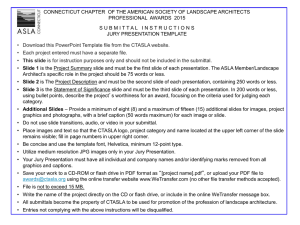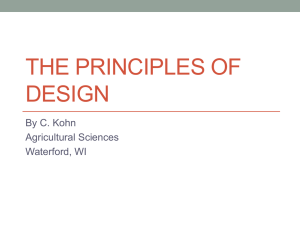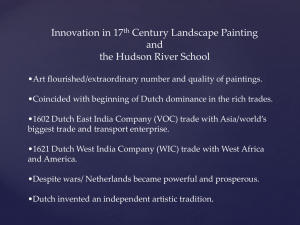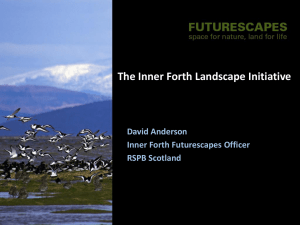LANDSCAPE VI - General Education @ Gymea
advertisement
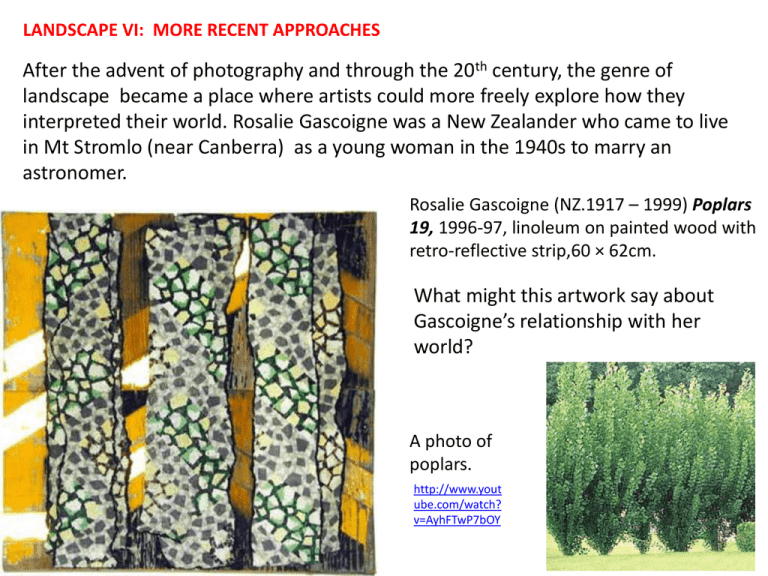
LANDSCAPE VI: MORE RECENT APPROACHES After the advent of photography and through the 20th century, the genre of landscape became a place where artists could more freely explore how they interpreted their world. Rosalie Gascoigne was a New Zealander who came to live in Mt Stromlo (near Canberra) as a young woman in the 1940s to marry an astronomer. Rosalie Gascoigne (NZ.1917 – 1999) Poplars 19, 1996-97, linoleum on painted wood with retro-reflective strip,60 × 62cm. What might this artwork say about Gascoigne’s relationship with her world? A photo of poplars. http://www.yout ube.com/watch? v=AyhFTwP7bOY Rosalie Gascoigne,(NZ.1917 – 1999) Suddenly the lake, 1995, formboard plywoods, galvanised iron sheeting, acrylic paint on composition board; four panels overall (approx.) 131 x 361 x 8 cm What can we say about this style of approach to landscape? What aspects of landscape are being represented? Is this kind of style as satisfying to look at as, say a more traditional Landscape painting? Colin McCahon (NZ 1919-1987) Tomorrow will be the same, but not as this is, 1959, enamel paint and sand, 182 x 122 cm Thinking about her artmaking practice, what would Gascoigne’s studio look like? Rosalie Gascoigne (NZ.1917 – 1999) Metropolis, 1999, cut-up road signs, 232 x 320 x 2cm Gascoigne said of herself as an artist ‘I know I cant draw, but I can arrange.’ She studied Ikebana – the ancient Japanese art which uses flowers, stalks, leaves and is a form of meditation. This would have helped her with skills in composition. Colin McCahon, who influenced Gascoigne, also used text in his work. He often quoted from the Bible. What is the difference in how we might respond To the artworks by the two artists? ( Colin McCahon (NZ 1919-1987) A question of faith, 1970, acrylic paint on unstretched canvas, 208 x 262 m Colin McCahon (NZ 1919-1987) Victory over death 2, 1970 acrylic paint on canvas, 207 x 598 cm John Wolseley (U.K. lives Australia, b. 1938) is an artist we’ve seen a bit of already. John Wolseley (U.K. b 1938) Fauvette Melanocephale, 2008, juniper charcoal, graphite and watercolour on paper 24 × 55.5cm In this work we can see evidence of what we saw him do in the DVD last week – going into the landscape, but not merely setting up an easel and drawing what he sees. Rather, he wants to collaborate with the landscape. He wants random marks that the trees or bushes or ground makes, and then does finely observed drawings over that. It’s a teamwork approach. What effect does this type of approach have on the viewer? John Wolseley (U.K. b 1938) Monsters of the Great South Land, 2005 watercolour and graphite on paper 55 x 290cm (paper size), Many artist, like Wolseley have ecological concerns and their art practice is about raising people’s awareness of the fragile nature of the planet. Note the format of this work. Bearing in mind the kind of work it is, with much fine detail, what effect might this have on the audience? Andy Goldsworthy (U.K. b. 1956) is another artist who responds to landscape. He creates installations – also referred to as site-specific sculpture or Land art within the natural environment. He goes out to investigate the environment using whatever natural materials are available to him. He then intervenes to create his installations. He then photographs the result. Andy Goldsworthy (U.K. b. 1956) Stone and snow arch, Dumfriesshire, 1986. “For me looking, touching, material, place and form are all inseparable from the resulting work. It is difficult to say where one stops and another begins. Place is found by walking, direction determined by weather and season. I take the opportunity each day offers: if it is snowing, I work in snow, at leaf-fall it will be leaves; a blown over tree becomes a source of twigs and branches.” How might we describe Goldsworthy’s relationship with his art? Andy Goldsworthy (U.K. b. 1956) Floating hole, Lougborough Leicestershire 1986



